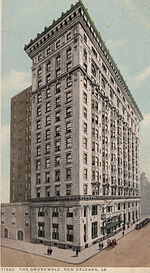Saenger Theatre (New Orleans)
Cinemas and movie theaters in LouisianaConcert halls in LouisianaEmile Weil buildingsItalian Renaissance Revival architecture in the United StatesMovie palaces ... and 9 more
Music venues in LouisianaNational Register of Historic Places in New OrleansPerforming arts centers in LouisianaSaenger theatresTheatres completed in 1927Theatres in New OrleansTheatres on the National Register of Historic Places in LouisianaUse American English from November 2019Use mdy dates from November 2019

Saenger Theatre is an atmospheric theatre in downtown New Orleans, Louisiana, which is on the National Register of Historic Places. Once the flagship of Julian and Abe Saenger's theatre empire, today it is one of only a handful of Saenger movie palaces that remain.
Excerpt from the Wikipedia article Saenger Theatre (New Orleans) (License: CC BY-SA 3.0, Authors, Images).Saenger Theatre (New Orleans)
Canal Street, New Orleans Storyville
Geographical coordinates (GPS) Address Website External links Nearby Places Show on map
Geographical coordinates (GPS)
| Latitude | Longitude |
|---|---|
| N 29.955797222222 ° | E -90.072844444444 ° |
Address
Saenger Theatre
Canal Street 1111
70112 New Orleans, Storyville
Louisiana, United States
Open on Google Maps










